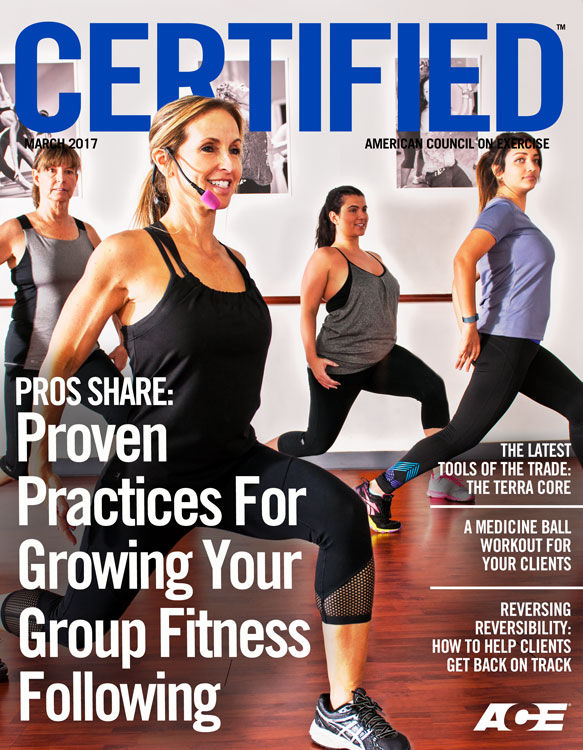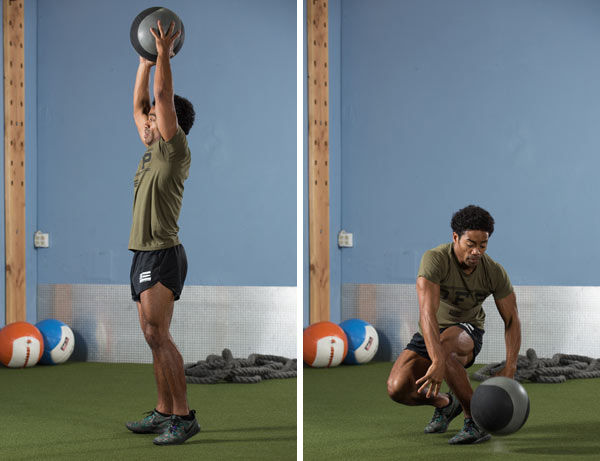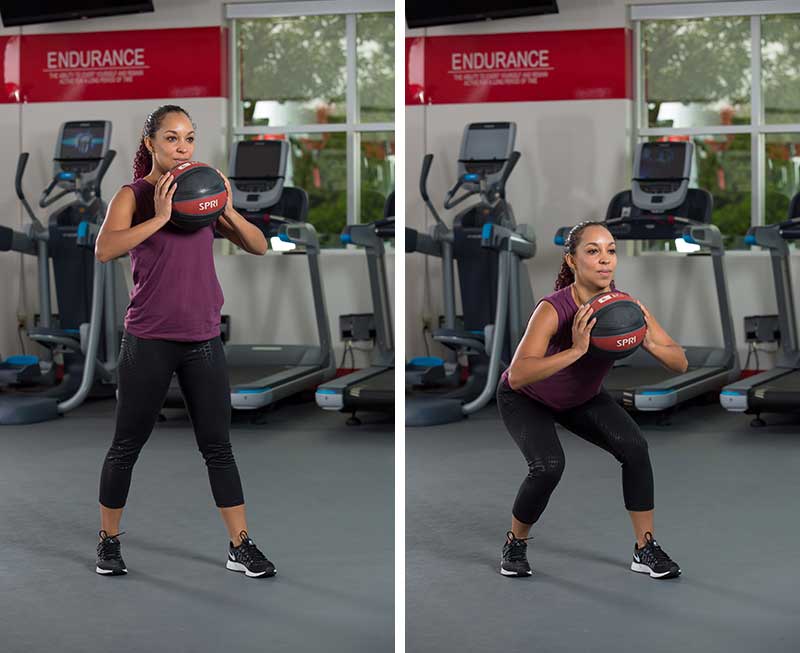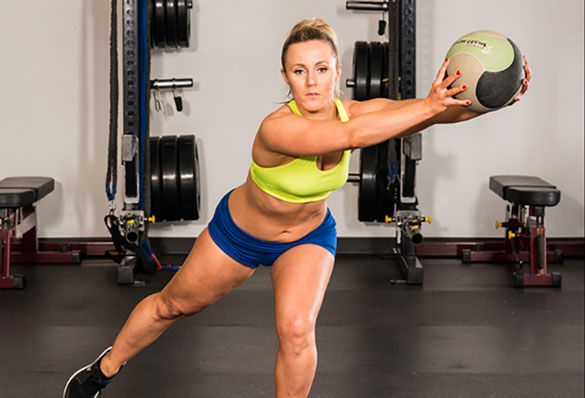
An exciting alternative to dumbbell exercises, medicine ball training is versatile, cost-effective and simple to teach, and it's time-efficient because it requires multiple body parts to work in harmony. Using just one weighted ball, you can help your training clients or class participants improve fitness, strength, posture, movement mechanics, athletic skills and more.
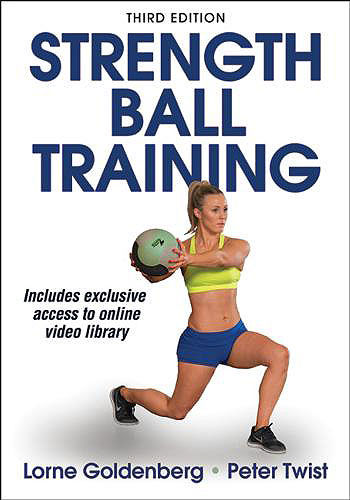
To that end, check out the eight-exercise med ball workout in this article, excerpted from the new, third edition of Strength Ball Training (Human Kinetics, 2016). Add a warm-up (see below) and try out the complete routine with the right clients, or insert individual exercises into your training sessions, boot camps and/or classes. First, consult the tips below for important guidelines and reminders about medicine ball training.
Warming Up
A dynamic warm-up helps clients increase core temperature and prepare their joints for the exercises to come. With med ball training, it’s a good idea to break down the warm-up into general and specific phases, says Lorne Goldenberg, co-author of Strength Ball Training (with Peter Twist) and Director of the UPMC Sports Performance Center in Pittsburgh. Goldenberg has worked with athletes from the National Hockey League and the Canadian Football League. “A general warm-up would include exercises such as walking lunges, torso twists, hip hinges, hops and wall push-ups,” says Goldenberg.
Immediately following the general warm-up, get into specifics: Have the client practice a few med ball exercises with lighter loads. For example, if a client will be using a 20-pound ball for the Standing Overhead Medicine Ball Rotation (shown below), Goldenberg suggests having him or her complete a submaximal set of lower reps with a 10-pound ball. “This will groove the motor pattern and result in a more effective loading pattern,” he says.
Progressions
Careful progression is part of any successful workout, especially when introducing a new training tool. Employ appropriate progression strategies, such as load, range of motion, lever length and bilateral-to-unilateral sequencing.
Med ball training in particular might also include faster movement patterns and twisting exercises, which is not as customary when using dumbbells. This is another reason for taking a sequential approach.
“Speed of movement, explosive throws/twists, etc., should be used with caution with clients who have never experienced this type of speed,” says Goldenberg. “They should be prepped with slow movement [first] and then progress to faster movements over time.” Strength Ball Training includes assessments and modifications for nailing down appropriate starting points for each client.
Tossing the Ball
Dating back to childhood, the first thing most people feel compelled to do when they hold a ball is to throw it, and med balls are no different. With partner training, you can toss the ball back and forth with a client or cue two or more clients to pass the ball between each other. (Over-the-Shoulder Throw shown in this article is a partner exercise.)
Keep in mind, however, that some clients might be able to hurl the ball hard. Ensure the recipient of a toss is: (1) able to manage the force, and (2) prepared to receive the throw.
“In an athletic environment, such as I have experienced in the NHL, safety always comes first,” says Goldenberg. “Clients of this caliber have the force and power to injure someone when throwing a heavy ball.”
Even with well-matched, non-athlete clients, inattention can lead to safety issues, especially if the med ball has the ability to bounce (some do, some don’t).
“Start partner exercises with the question: READY?” advises Goldenberg. The ball-tosser should wait for the recipient to confirm that he or she is ready to accept the ball.
Apply the tips and exercises in this article to deliver dynamic medicine ball workouts to your clients. For more exercise ideas and further direction on working out with medicine balls and also stability balls, refer to the Strength Ball Training book and its companion continuing education course.
The Workout
The following exercise excerpts have been reprinted with permission from Strength Ball Training (Human Kinetics, 2016), written by Lorne Goldenberg and Peter Twist. All exercise descriptions and images provided by Human Kinetics.

Standing Overhead Medicine Ball Rotation
Set-up
Your feet should be placed about shoulder-width apart, with a medicine ball held in the hands overhead. Focus on full body extension with knees slightly bent and legs loaded into a good athletic position.
Movement
Engage your core and begin by making a circular movement while maintaining the ball overhead. Movement needs to be slow and controlled.
Finish
Complete a set amount of rotations in each direction.
Tips and Progressions
- Start with small circular movements and progress to larger movements.
- Make sure you maintain your spinal position without overextending or flexing your low back.

Repeated Dual Foot Long Jump
Set-up
Stand with feet hip-width apart, holding a medicine ball at chest height close to your body.
Movement
Rapidly dropping your hips, explode forward in a horizontal fashion, whereby you attempt to drive your hips into extension as you rise off the floor. Drive the medicine ball into the air forward, enhancing full-body extension.
Finish
After you have come off the floor, land with a tall body but with soft hips, knees and ankles to absorb the landing, and finish in a tall position.
Tips and Progressions
- Do not land with fully flexed hips.
- Reset before each jump.

Over-the-Shoulder Throw
Set-up
Stand facing away from a partner, about two paces apart. Keep your feet shoulder-width apart, knees well flexed and abdominals contracted. Your partner is facing you (looking at your back), one step to the right.
Movement
Before you throw the ball, squat down and rotate to bring the ball in front of your right shin. The throw initiates from this position. Be sure to use a squat movement, dropping your hips to lower the ball to shin height so there is not excessive forward trunk flexion. The throw begins at the foot, transfers through your right leg, and transfers through the hips and torso and on to the upper body.
Remember, the desired ball direction is behind to your partner, not just up, so you must rotate through the torso and follow through behind you to direct the ball from above your left shoulder to your partner, who is standing behind you and off to your right.
Finish
Your partner catches the ball and rolls it back to your right side, where you can pick it up and move into the sequential throw technique. Repeat for the desired number of repetitions and then repeat the exercise throwing over the opposite (right) shoulder. Your partner will change his or her position, staying two paces behind you but shifting to your left side.
Tips and Progressions
- After you release the throw, keep your hands up above your shoulders.
- Your partner will catch your throw and return a gentle pass into your hands, where you catch it above your shoulders, rotate and squat to the opposite side.
- Then, thrust upward to throw the ball back over the same shoulder.
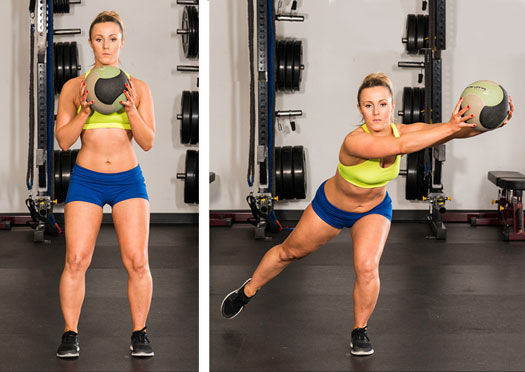
Single-Leg Stride Squat
Set-up
Hold a medicine ball in both hands in an athletic-ready position: quads loaded, hips dropped and torso upright.
Movement
Pick up one foot, extending the leg back at a 45-degree angle to stride out behind the body. The loaded leg lowers into a deep squat. Press the medicine ball diagonally away from the extended foot to the opposite side of the body.
Finish
Get length (through full body between medicine ball and back foot) and pause; hold without touching the back foot down. This is very challenging. Be sure to fully extend (straighten) the back leg. When achieved, the glutes will noticeably scream.
Tips and Progressions
- Squatting, striding and pushing at the same time presents an incredible challenge to the entire body. Common mechanical breakdowns are a triple play—coming up tall on the squat leg, falling into forward torso flexion and holding a bent back leg. Together, these three errors eliminate the potential exercise benefits.
- Progress this exercise by lowering deeper into the squat, striding fully by holding the heel of the foot higher while retaining a taller torso and/or reaching to full arm extension.
- Adding pauses in the most challenging position is an incredible demand in advancing strength.
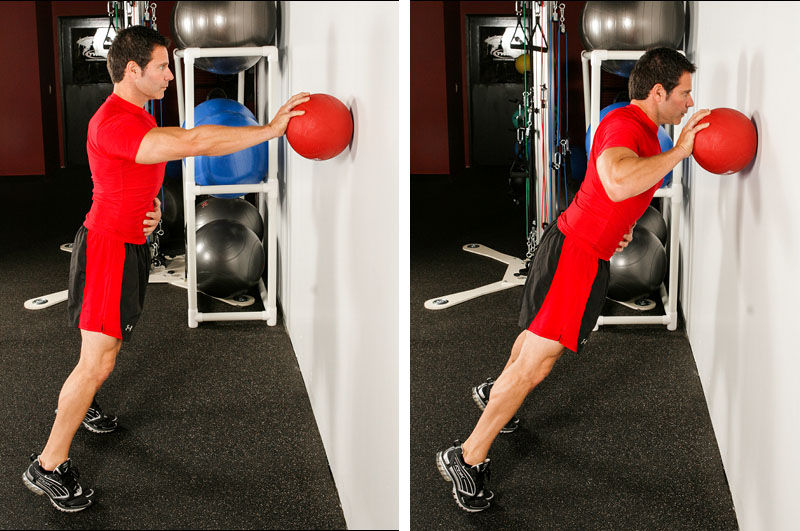
Standing Med Ball Press-Away
Set-up
Stand approximately 3 to 4 feet (about 1 meter) away from a wall. Place a medicine ball about 4 inches (10 centimeters) below the line from your shoulder, and hold the ball with an extended arm against the wall. You will need to be on your toes with your core engaged as you lean into the ball with your one arm. Do not allow any rotation in the core as you get into the set-up position.
Movement
While maintaining stabilization of your core, eccentrically lower your body toward the wall. You must do this in a slow and controlled manner.
Finish
Once you have lowered yourself down to a point where your shoulder is almost in full extension, press back out, again in a controlled manner. This movement is not meant to be performed with a fast tempo.
Tips and Progressions
- To increase the difficulty of this exercise, decrease the base of support by using a smaller medicine ball.
- Try unilateral leg support by raising the leg opposite the working arm.
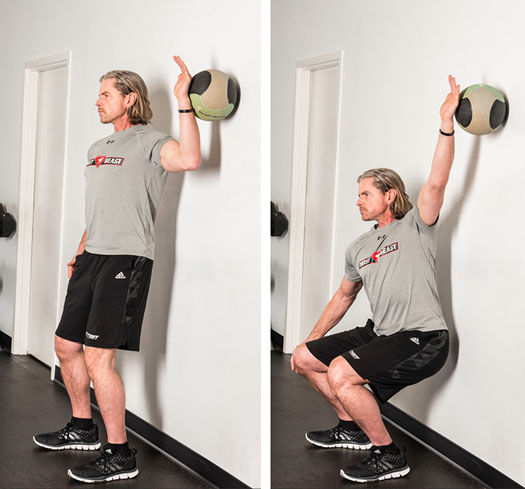
Med Ball Squat-Away Posterior Chain Wall Hold
Set-up
Begin facing away from a wall in a tall athletic-ready stance with the core engaged and the back of one hand pressing into a medicine ball to hold it in place. Position the ball so the hand is shoulder height, elbow toward the waist.
Movement
Hold the medicine ball in the same location the entire rep. Drop the body away from the ball by lowering into a deep squat, leaving the arm extended overhead.
Finish
Initiate the return back to a standing position with the upper back, not just the rear shoulders.
Tips and Progressions
- Sustain pressure against the ball at all times.
- If the ball begins to roll or falls to the floor, reset where you paused in that rep and continue.
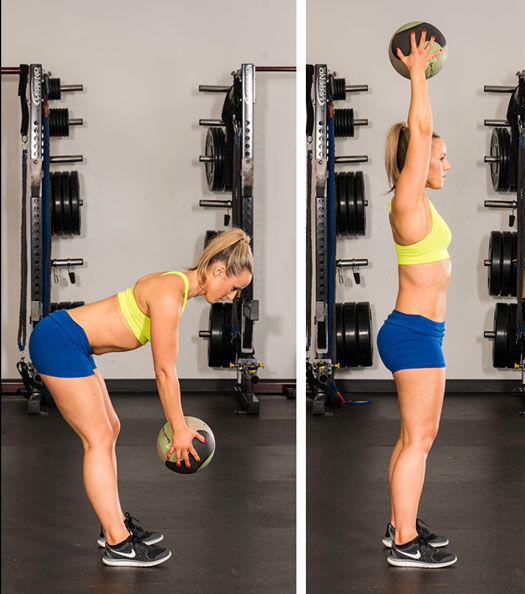
Med Ball Romanian Deadlift to Overhead Extension
Set-up
Stand in an athletic posture, holding a medicine ball with extended arms.
Movement
Begin the movement by engaging the core and pushing your hips backward while shifting your weight to your heels and not allowing your knees to bend any farther from the original athletic posture. Lower yourself to a point where you can maintain proper low-back posture.
Finish
Once you have reached your low position of the Romanian deadlift, come back up toward the starting position but raise the ball with extended arms all the way over your head. Lower the ball back to the starting position and repeat.
Tips and Progressions
- Do not allow your low back to flex forward or your knees to flex. In the overhead position, reach as high as you can.
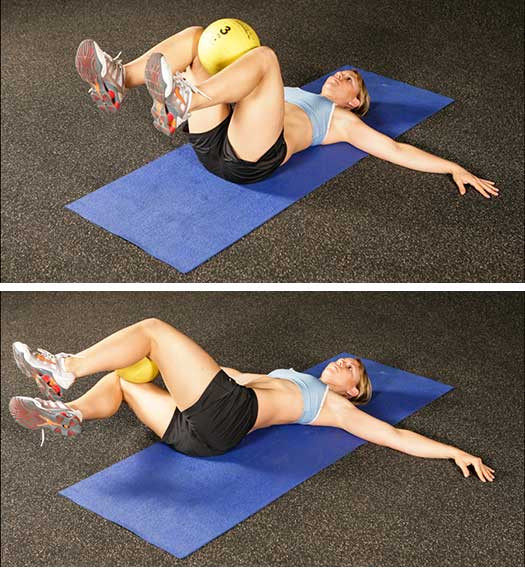
Twister
Set-up
Lie on the floor in a supine position with your arms straight out to the sides. Make sure you achieve a solid pelvic tilt. Set the abdominals before lifting the legs into the air. Legs are together and flexed to 90 degrees. Place a small medicine ball between your knees. Press inward to hold the ball in place and activate your adductors and hip musculature.
Movement
Slowly lower the knees under control, off to the right side. Shoulders and back must remain flat on the floor.
Finish
Lift the legs back up over your hips (still flexed) and onward to the left side. Lower to the left. Stop and return. Continue for the desired number of reps or until you lose neutral torso supine position.
Tips and Progressions
- Complete the same sequence with more speed. Drop the legs to the left, and activate your muscles to decelerate and stop before touching the floor. Return across the body to the opposite side.
- Position the legs into a straight position over the body and position the ball between the ankles to increase the lever arm and place the loading farther out on the lever.





 by
by 